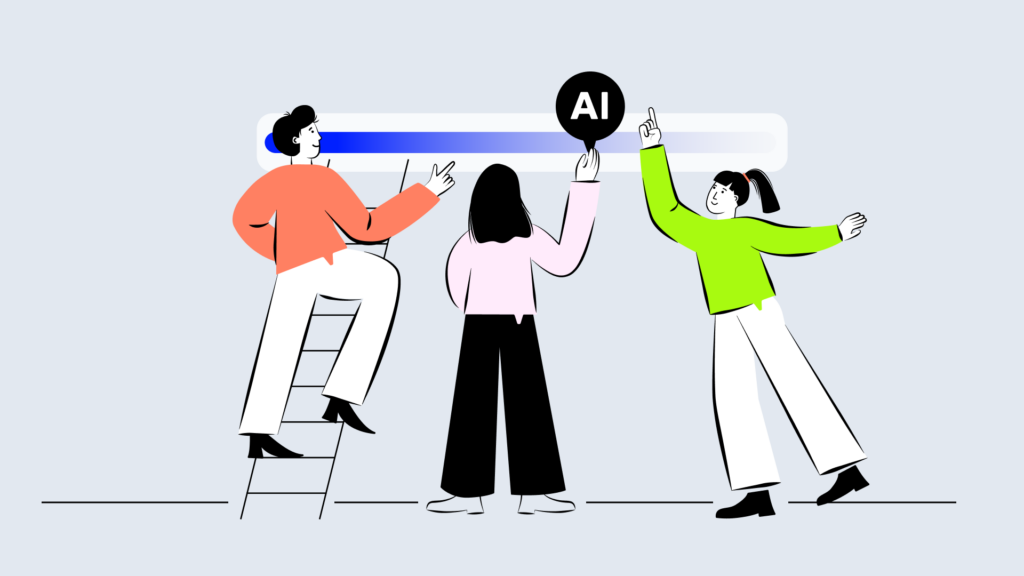Seamless AI Customer Service:
12 Real-World Examples

The fledgling AI customer service industry is growing steadily, with 80% of companies* either already using or planning to onboard customer service AI tools. But what’s their actual impact?
Despite all the hype that surrounds AI in customer service, statistics regarding its efficiency are sparse, mostly consisting of “x% of people thinks…”
Today, we seek to introduce you to 12 examples of artificial intelligence in customer service and find out whether the excitement is justified. Keep reading to learn more.
Key Takeaways:
- AI customer service boosts efficiency and personalization. Businesses improve response times, automate workflows, and tailor interactions without extra costs.
- Real-world AI implementations show success. CloudTalk, Netflix, Delta, and others use AI to enhance CX, reduce wait times, and increase efficiency.
- AI adoption comes with challenges. But they can be overcome with proper training, seamless integrations, and balanced automation.
Try Seamless AI Customer Service for 14 Days Free
The Role of AI in Modern Customer Service
Ever since AI and LLMs exploded into the public consciousness in the early 2020s, their commercial use has been the subject of hot debates and the target of wild funding, particularly in areas concerning automation and personalization.
The logical conclusion of these initiatives is AI customer service. Where companies used to struggle with maintaining both processual and financial efficiency in the past, they can now offload the majority of their repetitive and routine tasks to AI agents.
As we’ll discuss, businesses can deliver 24/7 customer service with improved response times and efficiently personalize interactions at scale without having to invest exorbitant resources in hiring additional customer service agents.
Key AI Technologies Powering Customer Support
Although there’s a wide variety of AI tools available, AI for customer service primarily focuses on leveraging 4 specific types of tools. These include:
- AI Chatbots & Virtual Assistants: Automate interactions across multiple touchpoints from your website to your helplines with chat and voice agents trained to answer the most common customer questions.
- AI-Powered Call Routing: Optimize agent workloads and prevent burnout by leveraging intelligent call pacing while delivering more relevant service via skill-based routing and Interactive Voice Response (IVR).
- Sentiment Analysis & Customer Insights: Automatically evaluate how your customers feel to escalate issues and save at-risk deals while learning from past interactions and improving future scripts based on behavior.
- Automated Workflows & Ticketing Systems: Speed up issue resolution while saving time on routine tasks by creating custom workflows for ticket creation, contact logging, tracking, and resolution suggestions.
12 Examples of Real-World AI Customer Service Use Cases
Now that we’ve covered the theory behind customer service artificial intelligence, let’s look at the reality. Below, you’ll find 12 real-world examples of AI in customer service.
#1: CloudTalk
CloudTalk is a leading provider of AI-powered call center software, closely familiar with leveraging AI outbound sales, delivering efficient 24/7 support for its customers, and providing companies with the tools necessary to achieve the same.
Our custom-built suite of AI Conversational Intelligence tools allows us to effortlessly keep track of all interactions with automatic call recording and transcription, and obtain critical information via sentiment analysis, topic extraction, and semantic search.
This has allowed us not only to improve our own productivity but also that of our customers. For example, Capitalo reduced its call quality analysis times by 83.3% and wrongly targeted leads by 24%. Similarly, Swile grew its pre-sale productivity by 30%.
#2: Zendesk
Zendesk is a leading industry provider of automation and integration solutions, helping its users save time and deliver highly personalized experiences through AI-driven chatbots, ticketing, and workflow optimization.
Tools like the Answer Bot help resolve common queries, while its intent detection and ticket triage assist in routing issues to the right agents. This has translated into 37% faster response times and a 15% boost in first-contact resolution for its customers.
#3: Comcast
Comcast is a global telecom leader and another AI customer service example, that uses AI to improve customer support, reduce wait times, and optimize service disruptions through intelligent automation.
Its AI virtual assistant troubleshoots technical issues while predictive analytics proactively alert customers to outages. This has led to a 30% reduction in wait times and a significant decrease in inbound support calls.
#4: Netflix
Netflix is one of the biggest video-on-demand (VOD) providers on the market today. It currently leverages AI to personalize customer experiences, refine content recommendations, and enhance automated support interactions across its platform.
Its AI chatbot handles common account issues, while sentiment analysis fine-tunes responses based on customer tone. These AI enhancements have resulted in faster issue resolution and higher customer satisfaction rates.
#5: Decathlon
Decathlon is a global sporting goods retailer that relies on AI to automate customer interactions, optimize product searches, and streamline support requests.
Its AI-powered chat assistant helps customers find products instantly, while automated ticketing systems improve service efficiency. These AI tools have helped automate 65% of customer queries and contributed to a 15% increase in online conversions.
#6: American Eagle
American Eagle, the US retail giant, integrates AI to enhance digital shopping experiences, automate support, and improve customer self-service solutions.
Its AI chatbot offers real-time style recommendations, while automated support tools assist with order tracking and returns. These features have reduced live chat volumes by 20% and improved customer satisfaction scores.
#7: Unity Technologies
Unity Technologies, a leader in gaming software, deploys AI-powered automation to assist developers and optimize support interactions at scale.
Its AI-driven help desk resolves common inquiries instantly, while natural language processing (NLP) improves response accuracy. These tools have reduced ticket resolution times by 40% and increased self-service adoption rates.
#8: Delta Air Lines
Delta Air Lines uses AI to enhance customer support, minimize disruptions, and personalize travel experiences for its passengers.
Its AI chatbot, Delta Virtual Assistant, manages flight changes, upgrades, and cancellations, reducing call center strain. AI automation has improved self-service resolutions by 60% and increased customer loyalty scores.
#9: Heathrow Airport
Heathrow Airport deploys AI-driven solutions to improve passenger assistance, enhance security, and streamline airport operations.
Its AI-powered chat assistant provides real-time flight updates, while predictive analytics optimize staffing to reduce delays. These enhancements have led to shorter queue times and improved traveler satisfaction.
#10: Klarna
Klarna, a leading fintech company, uses AI to automate customer support, detect fraud, and personalize payment experiences for its users.
Its AI chatbot handles account inquiries, while machine learning algorithms identify fraud risks and optimize payment reminders. These tools have helped reduce fraud losses and increase payment completion rates.
#11: Pizza My Heart
Pizza My Heart is a regional pizza chain that leverages AI automation to streamline phone orders, optimize order accuracy, and reduce wait times.
Its AI voice assistant takes phone orders, preventing miscommunication and optimizing delivery schedules. This AI implementation has led to a 25% increase in order accuracy and improved customer retention.
#12: Sam’s Club
Sam’s Club integrates AI-driven automation to enhance checkout experiences, optimize inventory management, and improve customer self-service.
Its AI-powered Scan & Go app reduces checkout friction, while virtual assistants assist members with inquiries. These solutions have cut checkout times by 50% and increased overall customer loyalty.
Key Benefits of AI in Customer Service
As we mentioned previously, the adoption of AI-powered tools has been steadily growing year over year, with 80% of businesses using or planning to use AI in some capacity. And for good reason. Here are the main benefits of AI in customer service.
Faster Response Times & 24/7 Availability
AI chatbots and virtual assistants help you deliver instant responses, reducing wait times and keeping support available 24/7. This ensures customers get immediate answers without relying on human agents.
Increased Agent Productivity
AI helps automate repetitive tasks, such as ticket classification and routine inquiries, allowing your human agents to focus on complex issues. This reduces burnout, improves efficiency, and enhances overall service quality.
More Personalized Customer Interactions
AI is able to accurately analyze customer behavior, past interactions, and sentiment to deliver tailored responses and proactive support. This helps you create deeper connections and boost customer satisfaction without much extra effort.
According to Zendesk, 68% of consumers say they’re happy to engage with AI assistants as long as they exhibit sufficiently human characteristics, such as friendliness, creativity, and empathy.
Cost Savings & Scalability
AI enables businesses to handle high volumes of inquiries without significantly increasing costs. Automated workflows reduce the need for additional agents, making AI a cost-effective solution.
Data-Driven Decision-Making
AI captures and processes customer interactions to identify trends, optimize workflows, and improve service quality. Businesses gain actionable insights that enhance CX and drive operational improvements.
Challenges & Considerations in Implementing AI in Customer Service
While AI delivers major benefits, onboarding customer service automation AI can be exceptionally difficult, requiring careful consideration and a cross-departmental effort to implement efficiently. Here are the biggest issues and how to overcome them.
Balancing Automation with Human Support
AI should enhance rather than replace human agents. If you over-rely on automation, you risk alienating your customers with “inhuman” treatment, especially in emotionally sensitive situations. Here’s what you should do to keep your CSAT up.
- Limit AI to repetitive tasks and leave complex issues to your employees.
- Train your AI on real interactions to improve its empathy and responses.
- Implement easy handoff mechanisms to let users switch to a live agent.
Data Privacy & Security Concerns
AI systems process sensitive customer data, making compliance with GDPR, CCPA, and other regulations a must. This is especially vital, as the use of “shadow AI” (3rd-party tools) that often lacks these measures has grown by 250% since last year.
- Encrypt all AI-driven communications and restrict access to authorized users.
- Regularly audit AI for compliance with global and industry-specific regulations.
- Use anonymized or synthetic data for AI training to protect customer identities.
Integration with Existing Systems
AI tools must work seamlessly with CRMs, ticketing software, and communication platforms. If integration is weak, you’ll end up with data silos and inconsistent experiences. Here’s how you can ensure seamless integration.
- Choose AI solutions with pre-built integrations for your tech stack.
- Use APIs and middleware to connect AI with legacy systems.
- Conduct small-scale pilot tests before full deployment to catch issues early.
AI Training & Accuracy
AI is only as good as its training. If it lacks up-to-date, relevant data, it may generate inaccurate or irrelevant responses and frustrate customers instead of helping them. Here are a few ways to prevent these issues.
- Continuously train AI models on recent and real customer interactions.
- Implement human-in-the-loop AI, where agents review and correct responses.
- Collect customer feedback and use it to refine AI decision-making over time.
Customer Adoption & Trust
Although customers have gotten increasingly comfortable with AI, growing its favorability rating to 67%, any customers still prefer human interactions. Here’s how to stop your AI from being impersonal and damaging your adoption.
- Let customers know they are talking to AI and set clear expectations.
- Design AI to sound natural and offer helpful, relevant responses.
- Provide an option to request a human agent to prevent frustration.
Choose CloudTalk for Seamless AI Customer Service
They say knowledge is power, so knowing how to take advantage of all the benefits that AI in customer service offers is twice as powerful. And now you know all that you need to join the businesses paving the way for creating exceptional customer experiences.
But that doesn’t mean doing so will be easy. So, why don’t you make it a little bit easier on yourself and partner with a company that can provide you both with the natural and artificial intelligence necessary to help your business succeed?
Experience What CloudTalk Can Do For You First-Hand
FAQs
How does AI improve customer service?
AI speeds up response times, personalizes interactions, and automates tasks, improving efficiency and satisfaction.
Can AI fully replace human customer service agents?
No, AI enhances service by handling routine tasks, but human agents are needed for complex issues and emotional interactions.
How do AI chatbots and virtual assistants work?
They use NLP and automation to answer questions, route requests, and provide self-service, improving AI customer experience examples.
What industries benefit the most from AI-powered customer service?
Retail, finance, healthcare, and telecom use AI for automation, personalized support, and automated outbound calls.
How does AI personalize customer interactions?
AI analyzes behavior and history to tailor responses, suggest solutions, and improve experiences in AI customer service examples.
How does AI handle customer sentiment and emotions?
AI uses sentiment analysis to detect emotions, escalate issues, and refine responses, as seen in examples of artificial intelligence in customer service.




















